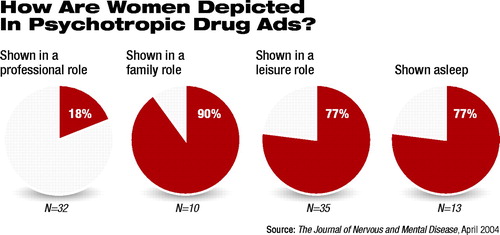Women's Depiction in Drug Ads: Holdover From a Bygone Era?
In spite of the expansion of women's roles over the last 20 years, ads for psychotropic drugs in scientific journals often persist in portraying women in traditional settings and roles.
A study that led to this finding was conducted by Donna Stewart, M.D., chair of women's health at University Health Network and the University of Toronto in Canada, and colleagues. Results appeared in the April Journal of Nervous and Mental Disease.
In their study, Stewart and her colleagues examined how often women and men were portrayed in psychotropic drug ads placed in three psychiatric journals during three different time periods. The journals were the American Journal of Psychiatry, Canadian Journal of Psychiatry, and British Journal of Psychiatry. The study periods were 1981, 1991, and 2001.
The proportion of women and men displayed in ads in all three journals in 1981 was about equal, the researchers found. However, the proportion of women had increased to 80 percent in the Canadian Journal of Psychiatry in 2001 and to 88 percent in the American Journal of Psychiatry in 2001. In contrast, the proportion of women portrayed in the British Journal of Psychiatry in 2001 had declined to 40 percent.
Trying to impart meaning to the findings, the researchers noted that given that women are known to be more at risk of depression than men, one possibility is that more antidepressant ads are run in these two journals today than in the earlier years and that women are depicted in the ads more often because they are more likely to seek treatment for depression. In fact, the researchers learned, only women were displayed in antidepressant ads in the American Journal of Psychiatry in 2001. But another reason why women appear in more psychotropic drug ads in the Canadian Journal of Psychiatry and the American Journal of Psychiatry today, the researchers suspected, may be a form of gender discrimination against women.

In fact, when the researchers examined the types of roles in which women and men were cast in the ads in the three journals across the three time spans studied, they found that most of the men were portrayed at work or in professional roles, implying productivity, independence, and a higher socioeconomic status, while most of the women were shown at home, in the garden, in a social situation, or asleep, implying traditional and dependent work roles.
“These findings,” the investigators suggested, “seem to indicate that, despite the great diversification and expansion of women's roles over the last 20 years, there is a consistent tendency in pharmaceutical advertising to represent women submissively (i.e., sleeping) or even in a sexualized manner (i.e., well-dressed, slim, younger, attractive) in traditional settings and roles....”
Stewart told Psychiatric News that she hoped clinical psychiatrists will “look beyond the images in pharmaceutical advertisements, which may not accurately reflect the images of many patients suffering from depression or psychosis—multicultural patients, men, the poor, the elderly, the disabled, and the physically unglamorous.”
An abstract of the study, “Who Is Portrayed in Psychotropic Drug Advertisements?,” can be accessed online at<www.jonmd.com> by clicking on the April issue and then the article title. ▪



